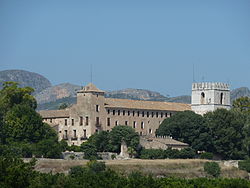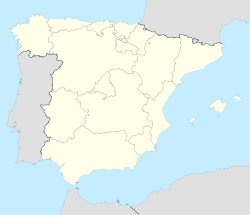- Monastery of Sant Jeroni de Cotalba
-
Monastery of Sant Jeroni de Cotalba
Monastery information Full Name Saint Jerome of Cotalba Royal Monastery Other Names San Jerónimo de Cotalba Order Hieronymites Established 1388 Disestablished 1835 Diocese Valencia People Founder(s) Royal Duke of Gandia Important associated figures Ausiàs March, House of Borgia, Duke of Gandia Site Location Alfauir, (Valencian Community), Spain Coordinates 38°56′00″N 0°15′31″W / 38.9333333°N 0.25861°W Visible Remains All. Fully preserved. Public Access Yes Other information The Monastery of Sant Jeroni de Cotalba (Valencian pronunciation: [ˈsaɲ ʒeˈɾɔni ðe koˈtaɫβa], Spanish: San Jerónimo de Cotalba, "Saint Jerome of Cotalba") is a monastic building of Gothic, Renaissance and Neoclassical styles constructed between the 14th and 18th centuries, located in the municipal area of Alfauir, (Valencia), Spain.
Contents
History
It is one of the most notable monastic constructions of the Valencian Community. In the village of Alfauir, some eight kilometres out of Gandia in the direction of Albaida is the monastery of Sant Jeroni de Cotalba. The monastery has its origins in Xàbia, where in 1374 Pope Gregory XI authorised its foundation to some hermit monks. Originally commissioned by the Royal Duke of Gandia Alfonso of Aragon and Foix in 1388 to save the friars from attacks by Berber pirates which they had been suffering whilst they lived in Xàbia. The family and the two wives of the well-known Valencian medieval poet Ausiàs March are buried in this monastery.
Afterwards, in 16th century, the monastery will have the protection of the Borgia family, being the Duchess of Gandia, Maria Enríquez de Luna, the one that realized works of extension in the monastery.
The popular legend tells that in one of the monastery's cloisters preached Saint Vincent Ferrer to the people.
Another personage of reference at the monastery is the Spanish Renaissance painter Nicolás Borrás. Upon entering the priesthood he was assigned to the Hieronymite Monastery of Sant Jeroni de Cotalba, where he enjoyed his stay so much that he asked for membership in the order has his only payment. He received the habit in 1575, and took the final vows the following year. He passed the rest of his life painting, leaving twelve altar pieces in the church alone. He also spent his own money in the employment of sculptors and builders for the embellishment of the monastery.
Following the Ecclesiastical Confiscations of Mendizábal, where religious buildings were sold off to pay state debts, it has been owned by the Trénor family in 1843. During the Spanish Civil War the monastery was used as a military hospital. The monastery was declared as an item of cultural interest (BIC) in 1994 and is now in the process of being restored and enhanced for visitors. Since May 2005 the doors to this building have been opened to the public. Coinciding with its opening to the public, restoration work has been carried out on the area behind the church’s retable and Father Borrás’ painting gallery, and restoring the monastery’s visitable parts. Nowadays, it's possible to visit the majority of the monastery.
The monastery supposes the beginning of the Route of the Monasteries of Valencia (GR-236), a religious, cultural and tourist route that connects five monasteries located in central region of the Province of Valencia, (Valencian Community). The Route of the Monasteries of Valencia was inaugurated in the year 2008[1][2] and this monastery is the first stage of the route.
The monastery
Construction work on the monastery began in the 14th century and continued up to the 16th century, though it was during the 17th and 18th centuries when it took on its present-day layout. Its most representative feature is its main facade, overlooked by the main tower and priory tower. The cloister is the backbone of the enclosure and is arranged in four galleries on two floors. On the lower cloister, the arches and vaults are made in two-coloured Mudejar style. The church stands on a rectangular ground plan with one aisle and chapels between buttresses. The most significant areas on the upper floor are the presbytery and the choir.
The complex encompasses the bell tower, with 17th-century blue and white carvings covering the façade; a gothic church with Baroque elements acquired during a previous renovation in the 18th century; a cloister with red Mudéjar arches resembling the architecture of the Córdoba mosque; a garden and the sala capitular, where a tomb houses the remains of Prince John and Princess Blanche of Aragon, children of the mediaeval Duke Alfonso the Old.
The constructed enclosure emphasizes the bell tower, where it's possible to find a copy of the entry in Valencian recalling the date and name of the founder.
Sections of the monastery
- Renaissance cloister double overlay.
- Gothic spiral staircase of the chapter house.
- The church.
- Romantic gardens.
- Gothic aqueduct.
Visits
Nowadays, it's possible to visit the majority of the building. To visit the monastery is advisable to consult the schedule updated of visits in the website of the monastery.
Gallery
Bibliography
- Este artículo incorpora texto del BIC incoado por la Consejería de Cultura de la Generalitat Valenciana
- es:Jesús Eduard Alonso López. Sant Jeroni de Cotalba: desintegració feudal i vida monàstica (segles XVIII y XIX). Gandía, CEIC Alfonso el Vell, 1988. ISBN 84-86927-00-5
- Fernando Mut Oltra y Vicente Palmer Terrades. Real Monasterio de San Jerónimo de Cotalba. Fernando Mut, Editor, Gandía, 1999. ISBN 84-60591166
- Francisco Javier Delicado Martínez y Carolina Ballester Hermán. El Monasterio de Cotalba (Gandía). Una fundación Jerónima del Siglo XIV. Universidad de Valencia.
- Mateo Gómez, Isabel, López-Yarto, Amelia y Prados García, José María, El arte de la Orden Jerónima: historia y mecenazgo, Madrid, Encuentro, 2000, ISBN 978-84-7490-552-6 pp. 281-284.
Notes
- ^ Source: El Mundo (Spain). The route of the Monasteries is inaugurated.
- ^ Source: Las Provincias. The route of the Monasteries: El Pas del Pobre.
See also
- Route of the Monasteries of Valencia
- PR-CV-100 (Route of the Monastery of Sant Jeroni de Cotalba)
- Dukes of Gandía
- Ausiàs March
- Pere March
- House of Borgia
- Nicolás Borrás
- Hieronymites
- Saint Vincent Ferrer
External links
- Website of the Monastery of Sant Jeroni de Cotalba
- Videos on youtube about the monastery
- Monastery's page on facebook
- The Monastery of Sant Jeroni de Cotalba
- The "Real Monasterio de San Jerónimo de Cotalba" - a slice of history
- The monastery on Valencia province Tourist Info
- The monastery on Gandia Tourist Info
- The monastery on La Safor area Tourist Info
Categories:- Monasteries in the Valencian Community
- Valencian Community
- Christian monastery stubs
- Spanish building and structure stubs
Wikimedia Foundation. 2010.







